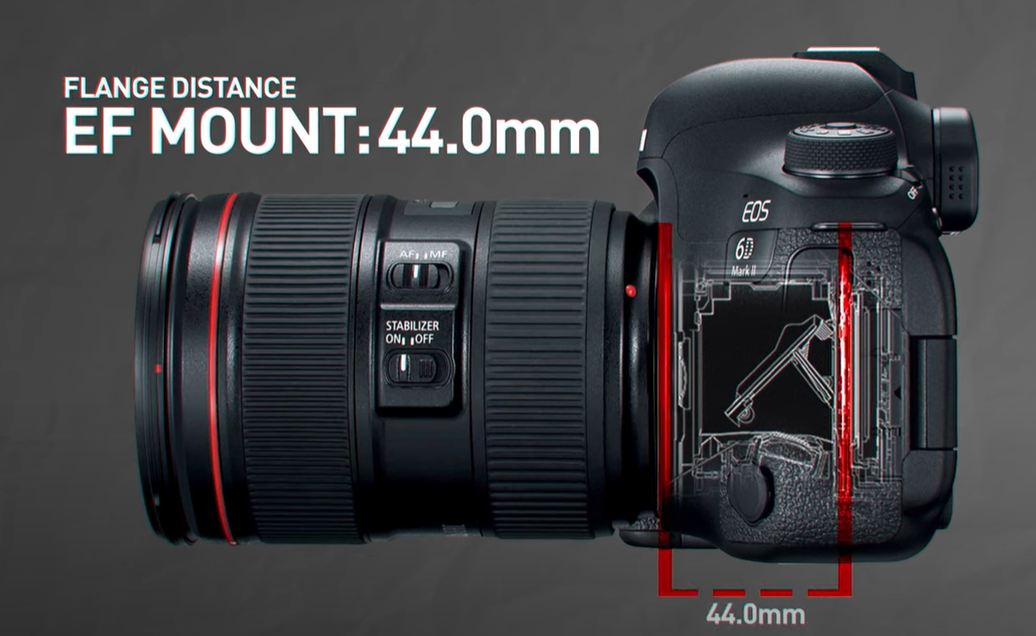Answer the question
In order to leave comments, you need to log in
Question for optics engineers, is it possible to create a lens / adapter for mounting an MFT lens on an EF camera?
As we all know, there are several types of camera lens mounts.
Each of the mounts has its own focus point, i.e. the distance from the lens to the camera matrix.
EF mount has a distance - 44mm

MFT mount has a distance from the optics to the sensor - 19.25mm

EF lens can be easily mounted on an MFT camera by increasing the distance from 19.25mm to 44mm. For this, adapters are used. Basically, they just lengthen the lens/camera (+24.75) so that the focus point matches.
But with the installation of an mft lens on an ef camera, there is a problem, since it is not possible to subtract the distance from the camera to the lens. To do this, you would have to cut off a piece of the lens or open the camera and push the optics closer. Those. make the necessary 19.25 from 44mm.

The question is, is it possible to solve the problem by the optical method? Those. make an adapter that will lengthen the focus point of the mft lens. Its focal point is 19.25mm, but you need to extend this focus point to 44mm. Both distances are always fixed.
Answer the question
In order to leave comments, you need to log in
I don't see any reason to use it. Even if you have expensive cine lenses. So people freaked out in 2008-9 when only 5dmII came out.
Now I would prefer a good picture with a stub than in the 2010s, when I had a lens for each bird (18,35,50,85,135).
Specifically to your question, there are two solutions,
1) use special adapters that add a lens in the middle. On this issue, Andrey Kramar can tell, he is engaged in the creation of anamorphic lenses.
2) Remove the mirror. So they bothered before, I don’t remember the name of the series of these cine lenses (no matter how compact prime from Zeiss on super 35), but almost every filmmaker wanted such an upgrade. And few did.
Both solutions will require a minimum of $500 in time and money. I would buy an additional carcass for the tasks necessary. The same blackmagic pocket.
Theoretically - why not? This must be a lens located at the focal point of the objective (19.25 mm) and having a focal length of 44 mm. And that's it! But we don’t theoretically need to get any kind of picture, and the optical characteristics of the lens cannot be spoiled. And in practice, the lens will turn into a complex system of lenses. At the same time, the characteristics of the resulting system will still be obviously worse than that of the original lens.
The result is an expensive thing, which also worsens the lens.
Yes, of course, for Nikon, for example, an adapter with a lens is quite popular, for old Soviet lenses.
But here everything rests on this lens, the extra lens spoils the optical design of the lens, the quality with the lens is worse.
You don't seem to understand what those speed boosters you refer to in the comments do and what they do.
Their function is not only to correct the working distance (from the rear lens of the lens to the sensor), which a simple "piece of pipe" usually does quite well. They also correct the image size by shrinking it because the 4/3 sensor is smaller than the APS-C sensor. This provides several advantages if such an adapter is not crap.
And what you want is (in addition to the focal length correction) to stretch the image, because lenses for the m4 / 3 system work with a smaller sensor. By stretching the image, you inevitably degrade the optical resolution (exactly the same as in the case of using extension rings for macro photography) and the quality of the final image. Also, by stretching the image, you make the amount of light per unit area smaller, which would force you to use a higher sensitivity to get the same exposure. (In the case of the speed booster, the effect is reversed.)
It is for this reason that no one needs such an adapter, you don’t even need it (well, unless you are satisfied with a muddy picture). I can’t even imagine a completely strange scenario - you need to somehow get hold of a very expensive and good m4 / 3 lens, but either don’t have a camera for it (which costs comparable to an adapter), or stubbornly refuse to wear it.
Didn't find what you were looking for?
Ask your questionAsk a Question
731 491 924 answers to any question